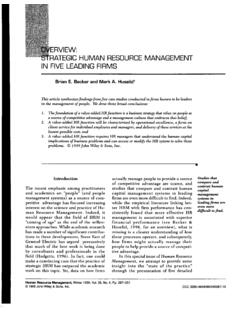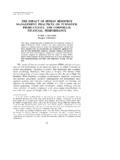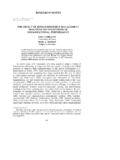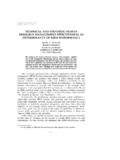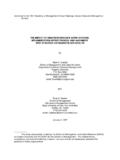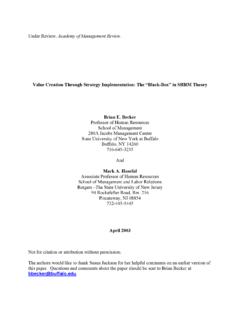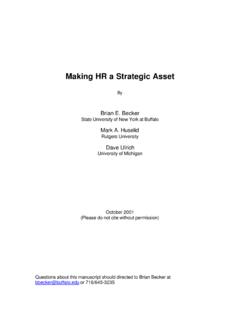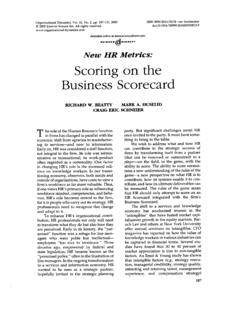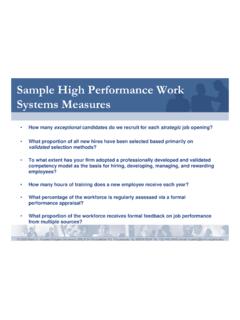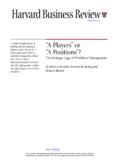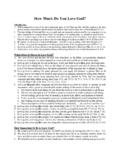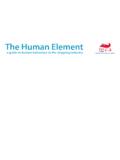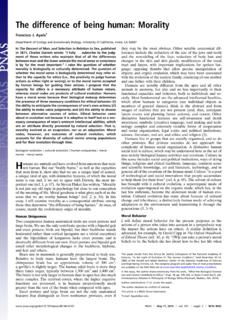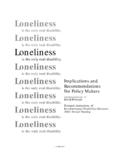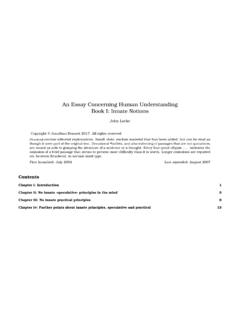Transcription of Strategic Human Resources Management: Where …
1 Strategic Human Resources Management: Where Do We Go From Here? Brian E. Becker*School of management , State University of New York at Buffalo, Buffalo, NY 14260 Mark A. HuselidSchool of management and Labor Relations, Rutgers University, Piscataway, NJ 08854 The authors identify the key challenges facing Strategic Human resource management (SHRM)going forward and discuss several new directions in both the scholarship and practice of focus on a clearer articulation of the black box between HR and firm performance,emphasizing the integration of strategy implementation as the central mediating variable in thisrelationship. There are direct implications for the nature of fit and contingencies in SHRM. Theyalso highlight the significance of a differentiatedHR architecture not just across firms but alsowithin :strategy; Human Resources ; black box; implementation; differentiationThe field of Strategic Human Resources management (SHRM) has enjoyed a remarkableascendancy during the past two decades, as both an academic literature and focus of man-agement practice.
2 The parallel growth in both the research literature and interest among prac-ticing managers is a notable departure from the more common experience, Where managersare either unaware or simply uninterested in scholarly developments in our field. As the fieldof HR strategy begins to mature, we believe that it is time to take stock of Where it stands asboth a field of inquiry and management practice. Although drawing on nearly two decades of898 We are grateful to Steve Frenkel, Dave Lepak, and seminar participants at Monash University for comments onan earlier version of this article.*Corresponding author. Tel.: 716 address: of management , Vol. 32 No. 6, December 2006 898-925 DOI: 2006 Southern management Association. All rights academic progress, this exercise is explicitly prospective. This article is not intended asan encyclopedic analysis of prior work (see Becker & Huselid, 1998, for an earlier review);instead, it will emphasize what we believe should be the future direction of the field duringthe next begin with the most pressing theoretical challenge facing SHRM, a useful articulationof the black box that describes the Strategic logic between a firm s HR architecture and itssubsequent performance.
3 How does the logic of this black box explain HR s contributionto a firm s sustained competitive advantage? Following recent work in the strategy literature,we call for a new emphasis on strategy implementation as the focal mediating construct inSHRM. Specifically, we argue that it is the fit between the HR architecture and the strategiccapabilities and business processes that implement strategy that is the basis of HR s contri-bution to competitive advantage. This will require an increasing level of differentiation of theHR architecture (Lepak & Snell, 1999), both within the firm and between we address the challenges facing future empirical work. That discussion is dividedinto two broad sections. First we consider the empirical implications of the proposed empha-sis on strategy implementation. We highlight the need for new measures of intermediate out-comes and the importance of estimating HR s impact in managerially significant , we examine recent challenges to the magnitude of HR s estimated effect on firmperformance in prior work.
4 Although we agree that questions of measurement error, omittedvariable bias, and mutual causation should be explored, recent studies that have examinedthese issues tend to raise more questions than they theoretical and empirical foundation highlights several new directions in SHRM research. In the next section, we extend this discussion of a future research agenda to severalrelated questions. This agenda is organized around four broad research questions and con-siders both the theoretical and empirical implications of our analysis. In several cases, thequestions and the methods mark a significant departure from past work in SHRM. Finally,we will assess the state of SHRM practice, both the remarkable progress and the significanthurdles facing HR managers looking to implement these Theory A New EmphasisThe field of HR strategy differs from traditional HR management research in two impor-tant ways. First, SHRM focuses on organizational performance rather than individual per-formance.
5 Second, it also emphasizes the role of HR management systemsas solutions tobusiness problems (including positive and negative complementarities) rather than individ-ual HR management practices in isolation. But Strategic means more than a systems focus oreven financial performance. Strategy is about building sustainable competitive advantagethat in turn creates above-average financial performance. The simplest depiction of theSHRM model is a relationship between a firm s HR architecture and firm performance. TheHR architecture is composed of the systems, practices, competencies, and employee perfor-mance behaviors that reflect the development and management of the firm s Strategic humancapital. Above-average firm performance associated with the HR architecture reflects thequasi rents associated with that Strategic , Huselid / Strategic HR Management899 For the most part, prior SHRM theory has focused on the nature of the HR is the nature of the appropriate HR system ( , single practices or systems)?
6 What arethe key mediating variables ( , commitment) within the HR architecture? The architecturalmetaphor (Becker & Gerhart, 1996; Becker & Huselid, 1998, Lepak & Snell, 1999; Wright,Dunford, & Snell, 2001) is important because it highlights the locus of value creation in Strategic Human capital is reflected in the Human assets in the organization, it iscreated and managed through the organizational system reflected in the HR notion of the HR architecture as a value-creating system raises the question of theappropriate locus of Strategic value creation. Emphasis in the SHRM literature ranges fromthe HR system, the resulting workforce skills and competencies, employee commitmentand engagement, to employee performance. Within this architectural framework, we wouldemphasize the importance of the HR system as the most important Strategic asset. First, it isthe source of value creation in the subsequent outcomes in the HR architecture.
7 Second, ithas the potential for greater inimitability based on how it is aligned with the firm s , unlike Human capital, it is a few exceptions (Becker & Huselid, 1998; Huselid, Beatty, & Becker, 2005;Huselid, Becker, & Beatty, 2005; Wright et al.), there has been little effort to extend SHRM theory in a way that formally integrates the mechanism through which the HR architectureactually influences firm performance. Gerhart (2005), for example, has recently suggestedthat SHRM move closer to the individual level by emphasizing HR s impact on employeerelations and attitudes. The heavy focus on the character of the HR architecture is the nat-ural comfort zone of HR scholars. Going forward, however, we need more theoretical workon the black box betweenthe HR architecture and firm performance, and less emphasis onthe black box withinthe HR architecture. The theoretical literature is out of is an intermediate or mesotheory, and as such, it draws as much on the strategy lit-erature as the HR literature.
8 Recent developments in the strategy literature, however, suggesta particularly valuable direction for theoretical work in New Emphasis on Strategy ImplementationThe resource -based view (RBV) of the firm has long provided a core theoretical rationalefor HR s potential role as a Strategic asset in the firm (Wright & McMahan, 1992). Thenotion that organizations can build competitive advantage, and as a result above-averagefinancial performance, based on valuable and inimitable internal Resources , offers an appeal-ing rationale for HR s Strategic importance. This integration tends to focus on Human capi-tal, or employee-level attributes, and the RBV s emphasis on recognizing existing strategicresources rather than the development of those Strategic assets. However, there is little evi-dence of the impact of this theoretical work on the empirical SHRM literature. Instead, themost we can say is that we have a set of empirical results that are consistent with the theo-retical implications of the strategy literature but do not follow from an SHRM theory thatdirectly integrates that theoretical literature.
9 As Barney (2001) has observed more broadlyabout the influence of RBV theory, the strategy literature simply provides a theoretical con-text for examining the implications of HR for firm of management / December 2006 Priem and Butler s (2001) concern about the level of abstraction in RBV theory appliesto SHRM theory as well. The link between the HR architecture and most RBV conceptsremains too abstract and too indirect to guide either empirical work on the black box inSHRM or management practice. However, recent attention to the independent influence of implementation in the strategy literature offers an opportunity to make the theoretical HR-firm performance link more concrete. As Barney has noted, implementation was originallyomitted from the RBV as a theoretical convenience, under the assumption that imple-mentation follows, almost automatically (2001: 53). Implementation has played a similarrole in SHRM theory.
10 Rather than considering implementation as an independent theoreticalconstruct, SHRM theory has relied on the implication that an appropriate match between theHR architecture and Strategic choice ( , Porter s positioning strategies like differentiationor cost leadership) results in effective theorists now recognize that the ability to implement strategies is, by itself, aresource that can be a source of competitive advantage (Barney, 2001: 54). Implementationshould be given similar prominence in SHRM theory. The HR system firm performance linkis not as direct as suggested by the prior SHRM literature. It has long been recognized thatintermediate outcomes, as part of an indirect link, are central to a more complete under-standing of how the HR architecture drives firm performance (Becker & Gerhart, 1996). Thequestion is, What are the most important intermediate outcomes?A new emphasis on strategy implementation in SHRM theory implies a new set of inter-mediate outcomes and a new locus of fit for the HR architecture.
